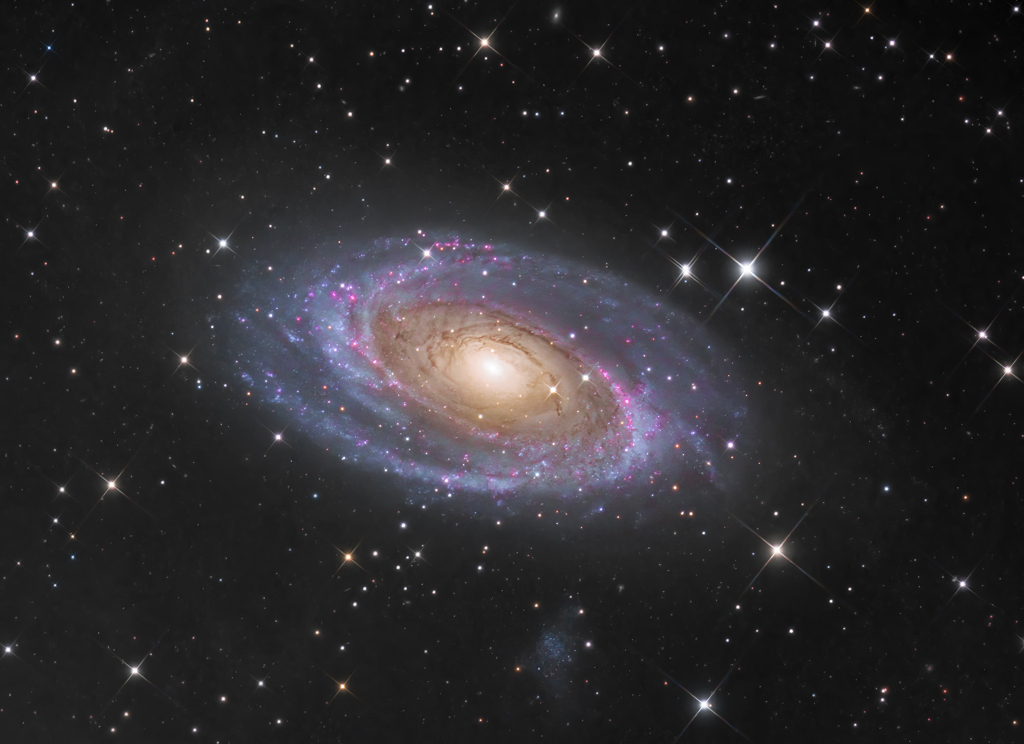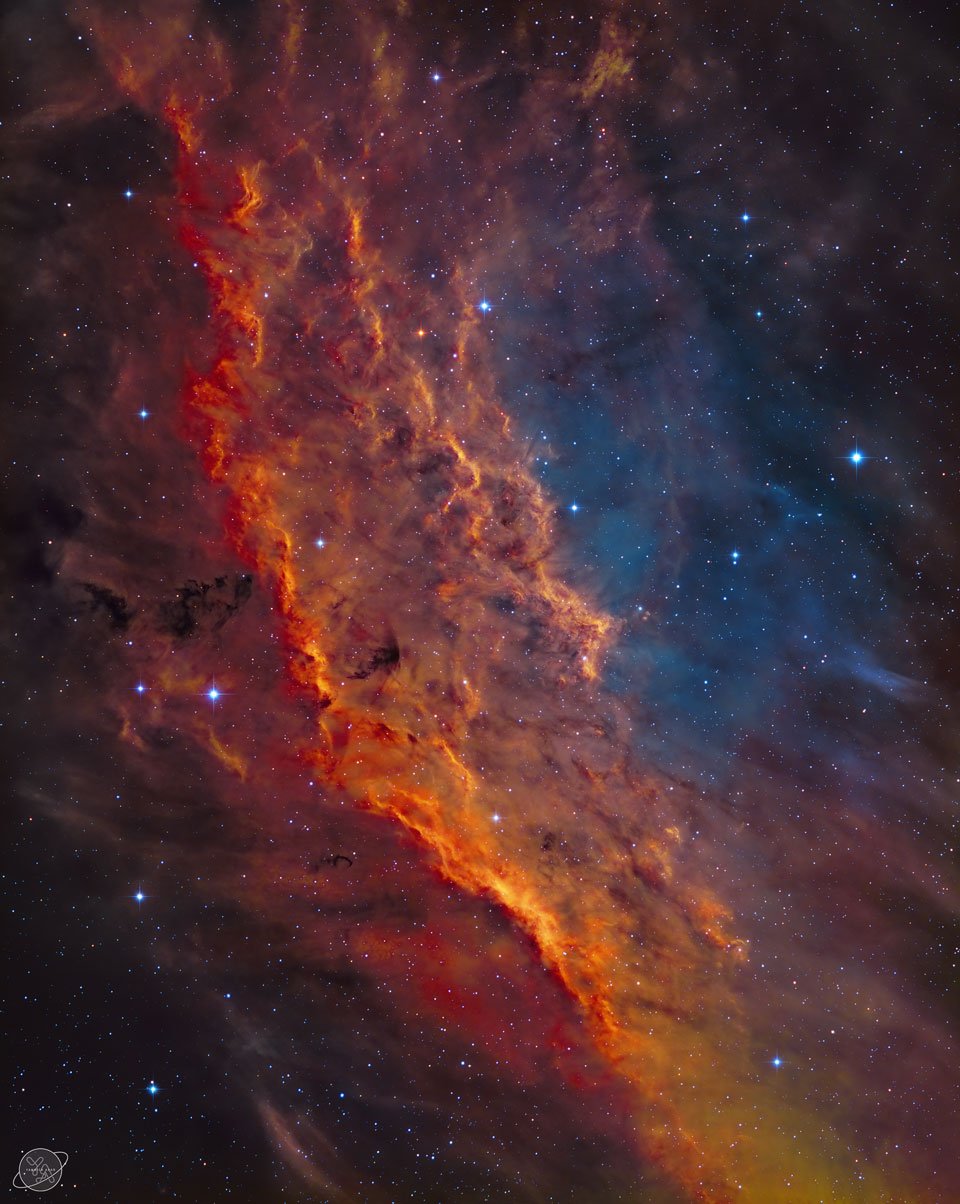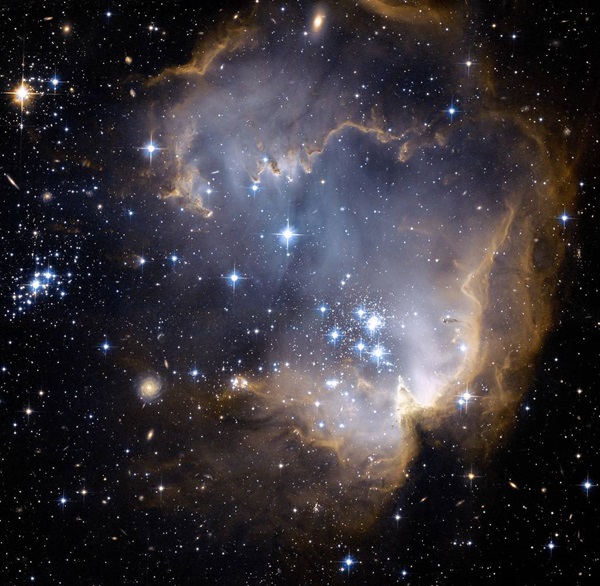Blog
One of the brightest galaxies in planet Earth’s sky is similar in size to our Milky Way Galaxy: big, beautiful Messier 81. Also known as NGC 3031 or Bode’s galaxy for its 18th century discoverer, this grand spiral can be found toward the northern constellation of Ursa Major, the Great Bear. The sharp, detailed telescopic view reveals M81’s bright yellow nucleus, blue spiral arms, pinkish starforming regions, and sweepingcosmic dust lanes. Some dust lanes actually run through the galactic disk (left of center), contrary to other prominent spiral features though. The errant dust lanes may be the lingering result of a close encounter betweenM81 and the nearby galaxy M82 lurking outside of this frame. M81’s faint, dwarf irregular satellite galaxy, Holmberg IX, can be seen just below the large spiral. Scrutiny of variable stars in M81 has yielded a well-determined distance for an external galaxy — 11.8 million light-years.

Alwin Lopez Jarreau (March 12, 1940 – February 12, 2017) was an American singer and musician. His 1981 album Breakin’ Away spent two years on the Billboard 200 and is considered one of the finest examples of the Los Angeles pop and R&B sound. The album won Jarreau the 1982 Grammyfor Best Male Pop Vocal Performance. In all, he won seven Grammy Awards and was nominated for over a dozen more during his career.
Jarreau also sang the theme song of the 1980s television series Moonlighting, and was among the performers on the 1985 charity song “We Are the World.” Jarreau was born in Milwaukee, Wisconsin, on March 12, 1940, the fifth of six children. His father was a Seventh-day Adventist Church minister and singer, and his mother was a church pianist. Jarreau and his family sang together in church concerts and in benefits, and Jarreau and his mother performed at PTA meetings.
more...Hugh Lawson (March 12, 1935 – March 11, 1997), was an American jazz pianist from Detroit who worked with Yusef Lateef for more than 10 years.
Inspired by Bud Powell, Hampton Hawes and Bill Evans, Lawson first gained recognition for his work with Yusef Lateef from 1957 onwards. He recorded with Harry “Sweets” Edison (1962), Roy Brooks, and Lateef again on several occasions in the 1960s. In 1972, he performed with “The Piano Choir” (Strata-East), a group with seven pianists including Stanley Cowell and Harold Mabern. He went on to tour with Charles Mingus in 1975 and 1977 and made recordings with Charlie Rouse (1977), George Adams, and as a leader.
Lawson died of colon cancer in White Plains, NY, March 11, 1997, at the age of 61.
more...Jesse Fuller (March 12, 1896 – January 29, 1976) was an American one-man band musician, best known for his song “San Francisco Bay Blues“.
Fuller was born in Jonesboro, Georgia, near Atlanta. He was sent by his mother to live with foster parents when he was a young child, in a rural setting where he was badly mistreated. Growing up, he worked at numerous jobs: grazing cows for ten cents a day; working in a barrel factory, a broom factory, and a rock quarry; working on a railroad and for a streetcar company; shining shoes; and even peddling hand-carved wooden snakes. By the age of 10, he was playing the guitar in two techniques, which he described as “frailing” and “picking.”
In the 1920s he lived in southern California, where he operated a hot-dog stand and was befriended by Douglas Fairbanks. He worked briefly as a film extra in The Thief of Bagdad (1924) and East of Suez. In 1929 he settled in Oakland, across the bay from San Francisco, where he worked for the Southern Pacific Railroad for many years as a fireman, spike driver, and maintenance-of-way worker. He married, and he and his wife, Gertrude, had a family. During World War II, he worked as a shipyard welder, but when the war ended he found it increasingly difficult to secure employment. Around the early 1950s, Fuller began to consider the possibility of making a living as a musician.
more...Don Drummond (12 March 1932 – 6 May 1969) was a Jamaican ska trombonist and composer. He was one of the original members of The Skatalites, and composed many of their tunes.
Drummond was born at the Jubilee Hospital in Kingston, Jamaica, to Doris Monroe and Uriah Drummond. He was educated at Kingston’s Alpha Boys School, where he later taught his younger schoolmate Rico Rodriguez to play the trombone.
His musical career began in 1950 with the Eric Dean’s All-Stars where he performed jazz. He continued into the 1960s with others, including Kenny Williams.
After performing jazz for a decade, Drummond began performing ska and in 1964 Don joined The Skatalites. With Drummond’s politicized conversion to the Rastafari movement, other band members followed his lead. He became a household name in Jamaica, before suffering mental problems. He was rated by pianist George Shearing to be among the world’s top five trombone players.
In 1965 Drummond was convicted of the murder of his longtime girlfriend, Anita “Marguerita” Mahfood, an exotic rhumba dancer and singer, on 1 January 1965. He was ruled criminally insane and imprisoned at Bellevue Asylum, Kingston, where he remained until his death four years later. The official cause of death was “natural causes”, possibly heart failure caused by malnutrition or improper medication, but other theories were put forward; some of his colleagues believed it was a government plot against the Kingston musical scene, and some believed that he was killed by gangsters as revenge for the murder of Mahfood. Heather Augustyn, author of a biography of Drummond published in 2013 claimed to have proved that Drummond’s death was caused by his medications.
more...Charles Phillip Thompson (March 21, 1918 – June 16, 2016) was an American swing and bebop pianist, organist, composer, and arranger.
Thompson was born in Springfield, Ohio, on March 21, 1918. His father was a minister and his stepmother played the piano. “He first studied violin and briefly played tenor saxophone, but took up piano as a teenager.” He moved with his family to Parsons, Kansas, in the southeastern part of the state. Later Thompson attended a Kansas City high school.
By the age of twelve, Thompson was playing private parties with Bennie Moten and his band in Colorado Springs, Colorado. During this time Count Basie played off and on with Moten’s band. During a show Basie called the young Thompson up to play. He was dubbed Sir Charles Thompson by Lester Young.
Thompson chiefly worked with small groups, including the Coleman Hawkins/Howard McGhee sextet in 1944–1945. Throughout the 1940s he played and recorded with Charlie Parker, Dexter Gordon, Miles Davis and J.C. Heard, among others. He played with Lucky Millinder‘s big band in 1946, and under Illinois Jacquet in 1947–48 and 1952.
He worked freelance, principally on organ, for much of the 1950s. He played with Parker again in 1953 and recorded with Vic Dickenson and Buck Clayton in 1953–54. Thompson worked with Earl Bostic in the late 1950s before heading his own quartet in 1959.
more...Alegrías (Spanish pronunciation: [aleˈɣɾi.as]) is a flamenco palo or musical form, which has a rhythm consisting of 12 beats. It is similar to Soleares. Its beat emphasis is as follows: 1 2 [3] 4 5 [6] 7 [8]9 [10] 11 [12]. Alegrías originated in Cádiz. Alegrías belongs to the group of palos called Cantiñas and it is usually played in a lively rhythm (120-170 beats per minute). The livelier speeds are chosen for dancing, while quieter rhythms are preferred for the song alone.
One of the structurally strictest forms of flamenco, a traditional dance in alegrías must contain each of the following sections: a salida (entrance), paseo (walkaround), silencio (similar to an adagio in ballet), castellana (upbeat section) zapateado (Literally “a tap of the foot”) and bulerías. This structure though, is not followed when alegrías are sung as a standalone song (with no dancing). In that case, the stanzas are combined freely, sometimes together with other types of cantiñas.
more...This image, which was released in 2007, has helped astronomers learn more about both NGC 602 and star formation in general. Further research on the cluster also revealed that not all of its stars were born at the same time. Based on data gathered by the Hubble Space Telescope, NGC 602 likely started forming new stars some 60 million years ago — and it was still giving birth as recently as a million years ago.
Harvey Mandel (born March 11, 1945, in Detroit, Michigan, United States) is an American guitarist known for his innovative approach to electric guitar playing. A professional at twenty, he played with Charlie Musselwhite, Canned Heat, the Rolling Stones, and John Mayall as well as maintaining a solo career. Mandel is one of the first rock guitarists to use two-handed fretboard tapping.
His first recording was the album Stand Back! Here Comes Charley Musselwhite’s Southside Band in 1966 with Charlie Musselwhite. Described in Legends of Rock Guitar (1997) as a “legendary” album, it was influential in bridging the gap between blues and rock and roll, with Mandel’s “relentless fuzztone, feedback-edged solos, and unusual syncopated phrasing.” He relocated to the San Francisco Bay area, performing often at The Matrix, a club where local favorites like Jerry Garcia or Elvin Bishop would sit in and jam. He then met the pioneering San Francisco disc jockey and producer Abe “Voco” Kesh (Abe Keshishian), who signed Mandel to Philips Records and produced his first solo album, Cristo Redentor, in 1968. Mandel recorded with Barry Goldberg on a bootleg from Cherry Records and recorded with Graham Bond. He cut two more solo LPs for Philips, Righteous(1969) and Games Guitars Play (1970), followed by four more solo albums for the independent record label Janus in the early 1970s, which included Baby Batter.
more...Robert Keith McFerrin Jr. (born March 11, 1950) is an American folk-jazz vocalist. He is known for his vocal techniques, such as singing fluidly but with quick and considerable jumps in pitch—for example, sustaining a melody while also rapidly alternating with arpeggios and harmonies—as well as scat singing, polyphonic overtone singing, and improvisational vocal percussion. He is widely known for performing and recording regularly as an unaccompanied solo vocal artist. He has frequently collaborated with other artists from both the jazz and classical scenes.
McFerrin’s song “Don’t Worry, Be Happy” was a No. 1 U.S. pop hit in 1988 and won Song of the Year and Record of the Year honors at the 1989 Grammy Awards. McFerrin has also worked in collaboration with instrumentalists, including pianists Chick Corea, Herbie Hancock, and Joe Zawinul, drummer Tony Williams, and cellist Yo-Yo Ma. He is the father of musicians Taylor McFerrin, Jevon McFerrin and Madison McFerrin.
McFerrin was born in Manhattan, New York City, the son of operatic baritone Robert McFerrin and singer Sara Copper. He attended Cathedral High School in Los Angeles, Cerritos College, University of Illinois at Springfield (then known as Sangamon State University) and the California State University, Sacramento.
more...Leroy Jenkins (Chicago, March 11, 1932 – February 24, 2007, New York City) was an American composer and violinist/violist.
Mother of Three Sons, a dance-opera based on African mythology created in collaboration with choreographer/director Bill T. Jones and librettist Ann T. Greene. Commissioned by and premiered at the 1990 Munich Biennial New Music Theatre Festival (Hans Werner Henze, artistic director). Also performed by the New York City Opera (US premiere, 1991) and the Houston Grand Opera (1992).
Fresh Faust, a jazz-rap opera in collaboration with librettist Greg Tate directed by Dominic Taylor. Performed at Boston’s Institute of Contemporary Art (1994).
more...Astor Pantaleón Piazzolla (Spanish pronunciation: [pjaˈsola], Italian pronunciation: [pjatˈtsɔlla]; March 11, 1921 – July 4, 1992) was an Argentine tangocomposer, bandoneon player, and arranger. His works revolutionized the traditional tango into a new style termed nuevo tango, incorporating elements from jazz and classical music. A virtuoso bandoneonist, he regularly performed his own compositions with a variety of ensembles. In 1992, American music critic Stephen Holden described Piazzolla as “the world’s foremost composer of Tango music”.
Piazzolla was born in Mar del Plata, Argentina, in 1921, the only child of Italian immigrant parents, Vicente “Nonino” Piazzolla and Assunta Manetti.His paternal grandfather, a sailor and fisherman named Pantaleo (later Pantaleón) Piazzolla, had immigrated to Mar del Plata from Trani, a seaport in the southeastern Italian region of Apulia, at the end of the 19th century. His mother was the daughter of two Italian immigrants from Lucca in the central region of Tuscany.
more...Alex or Aleck Miller (né Ford, possibly March 11 or December 5, 1912 – May 24, 1965), known later in his career as Sonny Boy Williamson, was an American blues harmonica player, singer and songwriter. He was an early and influential blues harp stylist who recorded successfully in the 1950s and 1960s. Miller used various names, including Rice Miller and Little Boy Blue, before calling himself Sonny Boy Williamson, which was also the name of a popular Chicago blues singer and harmonica player. To distinguish the two, Miller has been referred to as Sonny Boy Williamson II.
He first recorded with Elmore James on “Dust My Broom“. Some of his popular songs include “Don’t Start Me Talkin’“, “Help Me“, “Checkin’ Up on My Baby“, and “Bring It On Home“. He toured Europe with the American Folk Blues Festival and recorded with English rock musicians, including the Yardbirds, the Animals. “Help Me” became a blues standard, and many blues and rock artists have recorded his songs.
Miller’s date of birth is disputed. In a spoken word performance called “The Story of Sonny Boy Williamson” that was later included in several compilations, Miller states that he was born in Glendora, Mississippi in 1897. There are five opinions about his date of birth. Five opinions are 1897, 1899, 1907, 1909, and 1912. David Evans, professor of music and an ethnomusicologist at the University of Memphis, claims to have found census records that Miller was born around 1912, being seven years old on February 2, 1920, the day of the census. Miller’s gravestone in or near Tutwiler, Mississippi, set up by record company owner Lillian McMurry twelve years after his death, gives his date of birth as March 11, 1908. Upon his return to the U.S., he resumed playing the King Biscuit Time show on KFFA, and performed in the Helena, Arkansas area. As fellow musicians Houston Stackhouse and Peck Curtis waited at the KFFA studios for Williamson on May 25, 1965, the 12:15 broadcast time was approaching and Williamson was nowhere in sight. Peck left the radio station to locate Williamson, and discovered his body in bed at the rooming house where he had been staying, dead of an apparent heart attack suffered in his sleep the night before. Williamson is buried on New Africa Road, just outside Tutwiler, Mississippi at the site of the former Whitman Chapel cemetery. Trumpet Records owner McMurry provided the headstone with an incorrect date of death
https://www.youtube.com/watch?v=vb8jEPEfaLk
more...The outline of this molecular space cloud echoes the outline of the state of California, USA. Our Sun has its home within the Milky Way’s Orion Arm, only about 1,000 light-years from the California Nebula. Also known as NGC 1499, the classic emission nebula is around 100 light-years long. On the featured image, the most prominent glow of the California Nebula is the red light characteristic of hydrogen atoms recombining with long lost electrons, stripped away (ionized) by energetic starlight. The star most likely providing the energetic starlight that ionizesmuch of the nebular gas is the bright, hot, bluish Xi Persei just to the right of the nebula. A regular target for astrophotographers, the California Nebula can be spotted with a wide-field telescope under a dark sky toward the constellation of Perseus, not far from the Pleiades.

Norman Blake (born March 10, 1938) is a traditional American stringed instrument artist and songwriter.
Blake was born in Chattanooga, Tennessee, and grew up in Sulphur Springs, Alabama. He listened to old-time and country music on the radio by the Carter Family, the Skillet Lickers, Roy Acuff, and the Monroe Brothers (Charlie and Bill Monroe). He learned guitar at age 11 or 12, then mandolin, dobro, and fiddle in his teens. When he was 16, he dropped out of school to play music professionally.
In the 1950s, Blake joined the Dixieland Drifters and performed on radio broadcasts, then joined the Lonesome Travelers. When he was drafted in 1961, he served as an Army radio operator in the Panama Canal Zone. He started a popular band known as the Kobbe Mountaineers. A year later, while he was on leave, he recorded the album Twelve Shades of Bluegrass with the Lonesome Travelers.
more...More Posts
- Daily Roots Dennis Brown, Prince Jammy
- 911 Memorial 2023
- Rhythm Roots Workshop @ St Therese
- Cosmos NGC 3156
- Leo Kottke
- Victor Wooten
- Hiram Bullock
- Baby Face Willette
- World Drumming Abbilona
- Daily Roots King Tubby
- Cosmos M17
- Prince Lasha
- Dave Burrell
- Henry Purcell
- World Music Mary Anibal
- Daily Roots Lee Perry
- Cosmos C/2023 P1
- Doug Ingle
- Otis Redding
- Elvin Jones
